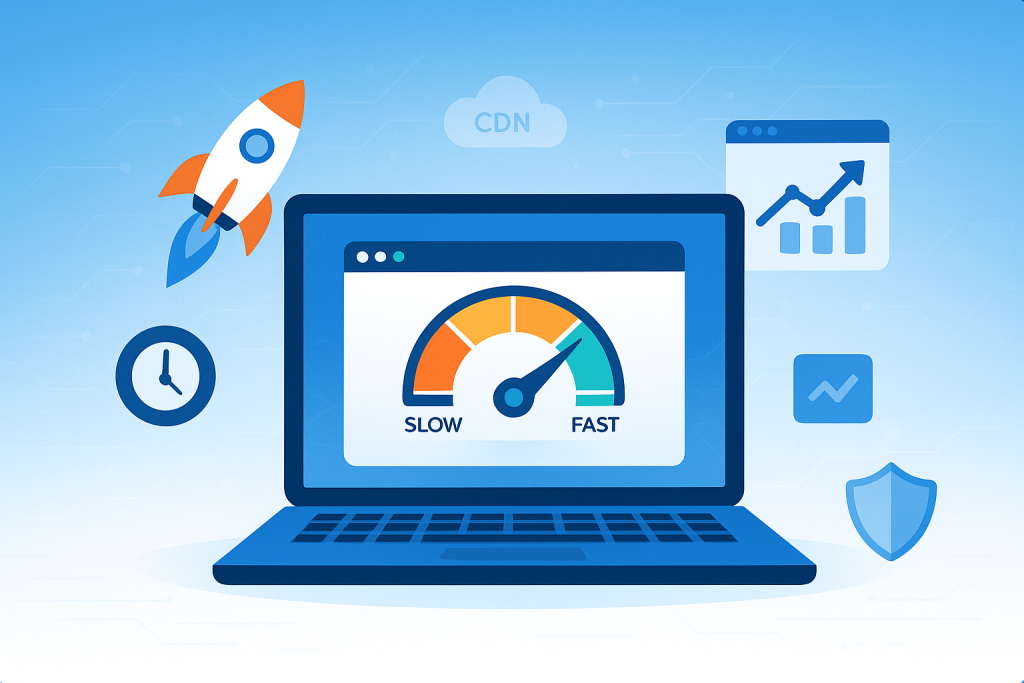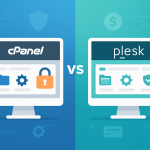In the digital world, speed is currency. Every millisecond counts. A website that takes three seconds to load is not just slow—it’s actively costing you revenue, reputation, and rank. Amazon once calculated that every 100-millisecond delay cost them 1% in sales, a staggering figure that underscores the economic reality of website performance.
In 2025, website speed optimization has moved far beyond simple image compression. It is now a highly technical, mandatory practice driven by Google’s Core Web Vitals (CWV) metrics, which place user experience directly at the center of SEO.
This ultimate guide will provide you with a structured, step-by-step plan to diagnose, optimize, and maintain peak performance, transforming your slow site into a conversion and ranking machine.
Part 1: Why Speed is Your Most Critical Business Metric
Understanding the “why” is crucial before diving into the “how.” Website performance is no longer a technical tick-box; it’s a strategic priority.
The Financial Cost of Slowness
- Bounce Rate: If your page takes longer than 3 seconds to load, the probability of a user leaving (bouncing) increases by over 90%.
- Conversion Rates: Studies consistently show that a 1-second improvement in load time can result in a 7% increase in conversions (sign-ups, purchases, or leads).
- Ad Revenue: Publishers with slow sites have lower RPM (Revenue Per Mille) because users spend less time on the page and ad viewability suffers.
The Google Mandate: Core Web Vitals (CWV)
Google now officially uses three specific metrics, known as Core Web Vitals, as crucial ranking signals. Achieving “Good” status on all three is essential for top SEO performance:
| Metric | What it Measures | Target Score |
| LCP (Largest Contentful Paint) | How quickly the main content on the page loads. | Under 2.5 seconds |
| FID (First Input Delay) | The time until the page is interactive and responds to user input (clicks, taps). | Under 100 milliseconds |
| CLS (Cumulative Layout Shift) | How stable the page is visually during loading (i.e., whether content jumps around). | Under 0.1 |
Part 2: The Optimization Stack (Diagnosis and Foundation)
Optimization is a layered process. You must start with the foundation—your hosting—before you touch code.
Step 1: Establish Your Performance Baseline
Before changing anything, you must know your starting point. Use these tools and focus on the CWV metrics:
- Google PageSpeed Insights (PSI): Provides the official CWV scores and a highly prioritized list of actionable fixes. Use this tool first.
- GTmetrix: Offers a detailed waterfall chart that visually identifies the size and load order of every file, helping you pinpoint the heaviest resources (usually images or large CSS files).
- WebPageTest.org: Excellent for testing speed from different geographic locations and conducting advanced tests like filmstrip and video comparisons.
Step 2: Upgrade Your Hosting Foundation (The TTFB Killer)
Your Time to First Byte (TTFB)—the time it takes for your server to start sending the first byte of data—is almost entirely determined by your hosting.
| Hosting Upgrade | Performance Impact | Why it Works |
| Shared to VPS/Cloud | Reduces TTFB by 50% or more. | Provides dedicated resources (CPU/RAM), preventing the “noisy neighbor” effect. |
| NVMe SSD Storage | Massively accelerates database queries. | NVMe is significantly faster than traditional SATA SSDs, crucial for dynamic sites (e-commerce, forums). |
| Latest PHP Version (8.x) | Up to 3x faster processing speed. | PHP 8.x is far more efficient than older versions (PHP 7.4), speeding up every script execution. |
| Server-Side Caching | Reduces TTFB to milliseconds. | Technologies like Varnish, Redis, or Memcached store processed pages in memory, bypassing PHP and database calls for static content. |
If your TTFB is consistently over 500ms, your problem is your hosting, and no amount of code optimization will fix it.
Step 3: Implement a Content Delivery Network (CDN)
A CDN is non-negotiable for any site with a global audience, and increasingly important even for local sites.
- Function: A CDN (like Cloudflare or BunnyCDN) caches static assets (images, CSS, JS) on global Edge servers. When a user requests content, it’s served from the server closest to them.
- Impact: This reduces latency (the delay caused by distance) and significantly accelerates the loading of external resources, directly improving LCP for global visitors.
- Pro Tip: Use a CDN that also offers image optimization and HTTP/3 support (like Cloudflare), as this bundles several optimization steps into one service.
Part 3: Mastering On-Page Optimization (Code and Assets)
Once the server is fast, the focus shifts to minimizing what the browser has to download and process.
Step 4: The Ultimate Image Optimization Strategy
Images are the single biggest performance bottleneck for most websites.
- Modern Formats (WebP/AVIF): Convert all JPEGs and PNGs to WebP format. WebP offers superior compression (25-35% size reduction) without visible loss of quality. AVIF is the next generation, offering even better compression.
- Responsive Images (
srcset): Never serve a 2500px image to a mobile phone screen. Use the HTML5srcsetandsizesattributes to ensure the browser loads the appropriate image resolution for the user’s device. - Lazy Loading: Apply native lazy loading (using
loading="lazy") to all images below the fold (not visible on first screen). This prevents the browser from wasting resources loading assets the user may never see. - LCP Focus: Ensure the Largest Contentful Paint element (often the hero image) is NOT lazy-loaded and is optimized for the highest priority.
Step 5: Taming Render-Blocking Resources (CSS and JavaScript)
The browser cannot start painting the page until it has processed all render-blocking CSS and JavaScript files. This is the primary killer of the LCP score.
- Minification (Steps 6 & 7 combined): Combine and minify all HTML, CSS, and JavaScript files. Minification removes unnecessary characters (comments, whitespace) to reduce file size.
- Critical CSS (The LCP Fix): Extract the bare minimum amount of CSS required to style the above-the-fold content and inline it directly into the HTML. This allows the browser to render the top of the page immediately.
- Defer Non-Critical CSS: Load the remaining, larger CSS files asynchronously (after the main content renders), using media queries to load specific styles only when needed.
- JavaScript Deferring (The FID Fix): Use the
deferorasyncattributes on your JavaScript tags.defer: Loads the script in the background and executes it after the HTML is fully parsed (best for most scripts).async: Loads the script in the background and executes it the moment it finishes downloading (best for independent scripts like Google Analytics).- This ensures the browser is fully responsive (good FID) while external scripts are still loading.
Step 6: Database and CMS Optimization
For CMS platforms like WordPress, the database can slow down your TTFB.
- Database Cleanup: Use a plugin (like WP-Optimize) to regularly clean up post revisions, spam comments, trashed posts, and transient options. A slim database is a fast database.
- Object Caching (Redis/Memcached): On a VPS/Cloud host, enable object caching. This stores complex database query results in RAM, eliminating the need to re-query the database for every page load.
Part 4: Advanced Techniques and Maintenance
To truly dominate the speed game, you need to go beyond the basics.
Step 7: Fix Layout Shifts (CLS)
The Cumulative Layout Shift (CLS) metric measures visual stability. Jumps in content happen when the browser loads elements without knowing their final size.
- Specify Image Dimensions: Always define the
widthandheightattributes in your image tags. This reserves the necessary space on the page before the image loads. - Font Loading Strategy (FOIT/FOUT): Avoid invisible text during webfont loading. Use techniques like
font-display: swapto immediately show a system font, then swap it when the custom webfont is ready. - Avoid Inserting Content Above Existing Content: Never use JavaScript to dynamically inject ads, banners, or notifications at the top of the viewport unless you reserve space for them first.
Step 8: Embrace Brotli Compression
While GZIP has been the standard, Brotli is a newer, more efficient compression algorithm developed by Google.
- Implementation: Ensure your host and CDN support Brotli compression. It can provide up to 20% better compression ratios for CSS and HTML than GZIP, resulting in smaller files and faster downloads.
Step 9: Monitor, Test, and Maintain
Optimization is an ongoing process, not a one-time task.
- Set up Monitoring: Use UptimeRobot to monitor load time, not just uptime. Check your Google Search Console’s Core Web Vitals report weekly for trends.
- Regular Audits: Run a speed test (GTmetrix/PSI) after every major change: a theme update, a new plugin installation, or a server configuration tweak. New plugins are the most common cause of sudden performance drops.
In 2025, every website owner must be a performance engineer. By focusing on your hosting foundation, implementing aggressive caching, optimizing your image delivery, and eliminating render-blocking resources, you can not only achieve passing Core Web Vitals scores but also build a seamless, high-converting experience that keeps users coming back.



